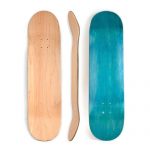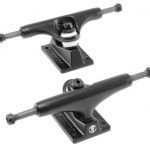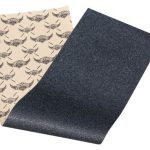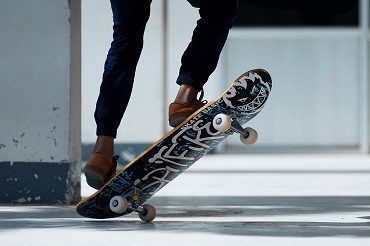Now that you have started Skateboarding, here are some useful tips.
Skateboarding Tips & Tricks
- There is no right or wrong way to skate. Skateboarding is an individualized sport, with each person doing their own thing, and having their own style. This article isn’t going to teach you how to go from a beginner skateboarder to pro, but it will provide you with a good base of information to get started.
- The first thing you want to consider when buying a skateboard is what kind of skateboarding you’ll be doing. Shortboards (which typically measure 28 inches to 32 inches) are an awesome choice if you’re skating streets, pools, ramp or skate parks, doing tricks, cruising, or vert skateboarding. In addition to length, key factors such as width, shape, concave, and wheel durometer all impact what type of skateboarding you can do. For information on cruisers or longboard skateboards, check out How to Buy a Longboard.
- Don’t compare your progress to others. Skateboarding is an individual sport, meaning you can progress at any rate you feel comfortable with. You might see someone who’s really good and who’s been doing it a lot longer than you have and wonder, “wow, why am I not there?” You will get there.
- Don’t risk injury to impress people. Being safe is a lot more important than looking cool in front of people at the skatepark. If you injure yourself, even if it’s a minor one, you won’t be able to skate for some time. So, if someone at the skatepark asks you to do some crazy drop in or something that you’re not sure you can do, stay safe and hold back. Sometimes, it’s not worth the risk.
- Don’t end your skate day on a bad note. Don’t let a trick ruin your day. We’ve all been there. You’ve had a great day at the skatepark, and you’re just gonna end your session with a trick you’ve done a few times before. But for some reason, you can’t land it. You’re throwing your board, yelling at the camera and when you fall, you just lay down for awhile. So, how do you let that not ruin your day? Go back to something you know how to do really well. Like, you could do it in your sleep. This does a few things, but mostly builds your confidence back up. You know you can skate and you know you can land tricks. So end your session on landing it! Better to end happy than angry.
- Be willing to try new things on your skateboard. The amount of creativity on a skateboard is limitless. There are all the basic tricks, but there’s more that can be added to those that add up to more diverse, interesting tricks. Don’t stay in one place, but keep progressing and keep learning more tricks. Push yourself forward and learn those tricks, so you can get better!
- Never. Give. Up. This applies to everything outside of skateboarding, but every skater need to hear this. If you can’t ollie, keep trying and trying until you do it. Just keep pushing. I’ve heard from many skater that they tried 1,000 times before they landed their first ollie. You’re starting from the beginning, and it can be awkward for some people. Don’t get beaten down, don’t give up. Just keep trying and you will land those tricks. You’re more than capable!
- The kickflip is arguably one of the most popular tricks in skateboarding. And when you see someone at a skate park, or in videos do it seamlessly, you can’t help but think, “I wanna learn that.” And you should! Many will get discouraged once they try and fail. The question to ask isn’t, “why can’t I do this?”, but “how’s my Ollie?”, “How comfortable am I on my board?” Focus on progressing on all the earlier steps, so the Kickflip is easier to land. The kickflip is not a beginner trick. You have to be in complete control of the board and feel comfortable on all stages of it. You have to be comfortable landing on it from a certain height, flicking it the right direction with the right amount of speed, don’t get discouraged if you can’t do a kickflip right off the bat. Go back to the basics. Ride your board everywhere, get your Ollies and pop-shuvits down. Then, you’ll be in a better place to master the kickflip.
Just like any other sport or recreational activity, skateboarding is something you actually have to get out and do if you are going to master it. No single article is going to teach you everything you need to learn. But there are some important tips and things you need to know before you step on the board for the first time — especially if you don’t want to get hurt!
The first thing to do for beginners is to stay balanced on the board. You have to keep doing this until you feel comfortable without regularly falling down. Once you can control the board, it is the right time for you to try some tricks. The best and easiest tricks for beginners include shove-it, grinding, Ollie or kick-flip. When you master those, take it one step at a time adding to your arsenal of tricks. If possible, this is a great time to get the help of someone who already knows how to do the tricks.
Step one is determining which foot to put in front and which foot to push with. Try both to see which feels more natural.
- Regular Stance means you feel more comfortable with your left foot in front.
- Goofy Stance means you feel more comfortable with your right foot in front.
There are so many different ways to figure out your stance on the board. Stand flat footed and have someone nudge you forward. Whichever foot you use to catch yourself is your dominant foot and should be placed in the back. Try to kick a football, the leg with which you kicked will your pushing leg placed on the tail.
≡ Don’t spend too much on your first skateboard!
You can get a complete pro skateboard for around $90-$100, less if you’re lucky. Consider buying a complete deck and avoid toy stores. Toy decks break easily, are heavy and have low-quality parts. Once you progress you can think of assembling a skateboard yourself using the components you want. We have complete decks for beginners on a budget. Shop Now
≡ Don’t be embarrassed.
It happens to every new skater. What will the neighbors think? I look like an idiot. Will people laugh at me because I have no idea what I’m doing. Don’t worry, this is perfectly normal. I’m a grown man, not bad at skateboarding but sometimes when I’m in a new park I get that same feeling. Everybody had to learn skateboarding at some point. We all sucked once. No skater is going to laugh at you, in fact, you could ask for help and people are willing to help you. Okay, people in the street might make remarks but who cares. You’re skating for you, to learn a new skill, to have fun. If it’s really too big of a deal for you, try to look for a quiet spot like an empty parking garage or use your driveway. Just keep going, it won’t take long before you can do some pushes and ride. I still get remarks from old ladies telling me I’m too old to skateboard. “it’s for kids!”. I just laugh and be on my way and come up with a witty answer 5 minutes later.
≡ Fear is normal, skate with confidence
It’s just something that’s part of skateboarding. Fear is what keeps you from injuring yourself, but sometimes it holds you back. If you’re just starting out, don’t do anything you’re not ready for. About 33 percent of skateboarder ending up in the hospital are newbies. To be fair, It’s not easy to overcome fear. You know you can do something, you have the skill but there’s still the fear of falling. Just wrap yourself in protective gear, it will give you confidence and you won’t tighten your muscles too much because you’re scared. Slowly build up, don’t plan on landing the trick just get a bit of a feeling. You shouldn’t think too much. If you want to do that first drop-in and are standing there for 5 minutes, walk away. Go do something else and go back. If you think too much, you’re gonna have a bad time.
≡ Find a smooth flat surface
Before you decide to ride, scout the area for pebbles, twigs and keep an eye out for glass shards. A smooth surface will help you to prevent nasty unexpected tumbles that you can’t prepare for. Ideally, you can practice in skate parks, this might be intense as there are many skaters so going early in the morning is a good way to avoid them. It also may be less awkward. Use parking lots (preferably empty) or your driveway if you don’t have a skate park nearby.
≡ Out of shape? Work out first
People who regularly exercise will pick up skateboarding much faster. You also have more risk of injury when you’re out of shape. I don’t mean you have to be athlete fit, but if you’re exhausted after walking a mile, you should work on that first.
≡ Skate as much as you can
Skate at every opportunity you get, preferably every day. Take your board to work, school, friends etc. Starting out with a skateboard just for commuting is a great way to get used to a skateboard. You’ll probably want some softer wheels to make the ride pleasant.
≡ You’re never too old!
Age does matter but it doesn’t mean you can learn to skateboard at 40. Starting out when you’re an adult isn’t impossible but you’ll pick up skateboarding faster when you’re younger. If you’re let’s say, over 27, it will be harder. After your 30’s you should really make sure to wear proper protection. You won’t heal easily, fall harder and you probably have responsibilities. I’ve dedicated an article for skateboarders over 30 if you’re interested.
If you are a professional or an amateur, the right equipment always makes the difference, you have to keep in mind a few things before choosing the right skateboard.

Deck is the main platform on which the skater stands. It is made up of seven veneers of wood, bent in a concave shape. The tips of the deck are called nose and tail, they provide leverage for the feet and helps the skater to perform highly technical tricks. The sizes of the deck are determined in inches.

Made of polyurethane, wheels are measured in millimeters (the diameter so a good size for street skating is anything from 49 – 52 mm. And as for transition or vert skating, you would go for something around 54 – 60 mm. They are larger and cover more surface area hence enabling you more speed for those airs or grabs. Wheels are stuffed with bearings and they are mounted on the trucks which are then screwed below the deck. Avoid cheap plastic wheels.

Trucks are the t-shaped metal pieces on which the wheels are mounted, there are fiber bushings inside the trucks which helps the skater to lean and turn the board in every direction. We have aluminum drip casting trucks with hollow kingpin (first time in India) for premium quality experience and longevity of equipment. It is super important when getting a skateboard to make sure that it has metal trucks, any board with plastic trucks is just a glorified piece of junk and not worth your money no matter how cheap it is!

This is an abrasive paper (Sand paper) coating on the deck which helps the skater to maintain grip with the shoes. It is an adhesive sticker which is applied on the deck. Never buy a skateboard without a griptape.
Research studies show that skateboarding as a whole is no more dangerous than most other sports. As a matter of fact, in terms of the chance of getting injured, it’s actually safer than many popular sports. The Consumer Product Safety Commission says that the number of skateboarding injuries is typically 8.9 per 1,000 participants, which is low. Basketball, a non-contact spot, has a 21.2 ER-treated injury per 1,000 players’ rate. So, tossing yourself down a double set is technically safer than playing a game of H-O-R-S-E.
The 2002 Comprehensive Study of Sports Injuries in the U.S., done by American Sports Data, found 3.1 injuries per 100 study participants (2%) below what might be considered more “mainstream” sports — basketball (13.8%), running/jogging (8.2%) soccer (8.1%), football (5.4%), baseball (3.0%), recreational bicycling (2.2%), tennis (2.1%), and ice hockey (2.1 %). The main safety issues come more from people who take more risks rather than from the sport itself. Another area of concern is with children because they have a higher center of gravity and less developed motor skills and balance, which makes them more likely to fall without proper training. Younger children also tend to be less aware of their surroundings, which increases the risk of collisions. Another thing that these studies show is that proper protective gear, especially helmets, reduces the severity of injuries, and just like with snowboarding, increased usage is a contributing factor in the overall reduced injury numbers.
The most common injuries associated with skateboarding are to the head, face, hands, wrists, shoulders and ankles. This range from minor scrapes and bruises, to sprains and breaks, all the way to potentially life-threatening concussions and traumatic brain injuries. Over 125,000 skateboarders sought emergency medical treatment in 2015, and it’s estimated that one-third of all emergency room visits for skateboarding injuries were brand new skaters with less than a week of experience. And 60 % of injuries involve children under the age of 15.
Another thing that these studies show is that proper protective gear, especially helmets, reduces the severity of injuries, just like it does for snowboarding. Whether you are riding your skateboard for fun and tricks, or using it as a method of transportation, using protective will ensure your safety — especially if you are a beginner. A helmet can protect your head while knee pads, elbow pads and wrist guards can protect your arms and legs from injuries. Wearing the proper shoes also will reduce the chance of falls.
Pros of Wearing a Helmet
- Higher visibility for drivers while you are skating on road.
- Less chance of fatal head injuries.
- Reduce recovery time from major falls.
- Not ending up in the hospital and able to go to work or school the next
Cons of Wearing a Helmet
- Helmets are uncomfortable since it makes you sweat. Aesthetically speaking, helmets don’t look “cool” and it messes up your hair. Well, this is not a beauty contest.
Based on these points, we can say that there are more logical reasons to wear a helmet.
Most skateboarders stop progressing at some point. You don’t seem to get better and learning new tricks seems impossible. Often this has to do with skipping the basics or you’re getting too frustrated and over-focused. To get better at skateboarding you need to slowly build up and make sure you master the basics. Sometimes your muscles and brain need time to adapt and a break can help you to improve. Make sure to get feedback from skilled skateboarders and film yourself to analyze your technique. Try riding Fakie (Backwards).Master manuals,
Rome was not built in a day!
A longboard is a skateboard with a deck longer than 33″. They have become increasingly popular over the years, and appeal to many people because they are easy and fun to ride. Even if you’ve never been on a skateboard before, you can learn to ride a longboard in no time. Longboards are fully customizable to fit exactly what you want out of your skating experience. Cruiser, downhill skateboard, and slalom are all types of longboard. Many people ride longboards for transportation–their maneuverability and speed make them ideal for commuting to class, or simply cruising around. Compared to a traditional street skateboard, longboard decks are constructed and shaped to give riders a wider, more stable stance when cruising, carving, or riding downhill. In addition to deck size, longboard wheels are typically larger and softer than that of shortboards, which makes for a smoother ride. Longboards are also used competitively for slalom and downhill racing because of their speed capabilities.
Method #1
If you plan to reuse the skateboard bearings from your old wheels, extract them from the wheels using a bearing puller, making sure not to damage the bearing shield in the process. Only grab the edges of the bearing with your tool, not the surface. You will most likely want to clean your bearings after you remove them. Check out our Bearing Maintenance Section
Method #2
If you don’t have a bearing puller handy, there is another way to remove bearings using just your own two hands and a little bit of force. Please note that this DIY method can damage your bearings, so it’s best to only use this method if you don’t plan on reusing the bearings. Start by unscrewing the nut on the axle. Remove the wheel and any spacers or shields on your axle and flip your board on its back, so the trucks are facing up. Slip the wheel onto the tip of the axle you want the axle tip to be about midway through the first bearing. Using a bit of force, press down with the inner edge of your palm until the wheel pops off the bearing. Repeat on both sides for all wheels.


I have really enjoyed reading this article. Skating is a personal activity and isn’t just about doing tricks. Each person does their own thing and has their own style. There is no single path to becoming a professional skater. You will need to practice your skills and get feedback from others.